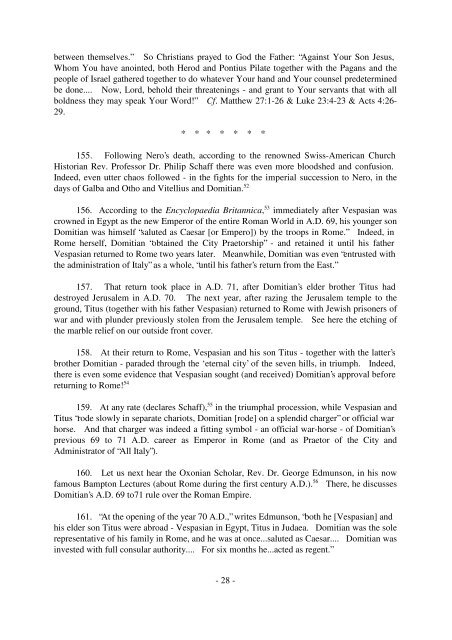JERUSALEM; ROME; REVELATION - The Preterist Archive
JERUSALEM; ROME; REVELATION - The Preterist Archive
JERUSALEM; ROME; REVELATION - The Preterist Archive
You also want an ePaper? Increase the reach of your titles
YUMPU automatically turns print PDFs into web optimized ePapers that Google loves.
etween themselves.” So Christians prayed to God the Father: “Against Your Son Jesus,<br />
Whom You have anointed, both Herod and Pontius Pilate together with the Pagans and the<br />
people of Israel gathered together to do whatever Your hand and Your counsel predetermined<br />
be done.... Now, Lord, behold their threatenings - and grant to Your servants that with all<br />
boldness they may speak Your Word!” Cf. Matthew 27:1-26 & Luke 23:4-23 & Acts 4:26-<br />
29.<br />
* * * * * * *<br />
155. Following Nero’s death, according to the renowned Swiss-American Church<br />
Historian Rev. Professor Dr. Philip Schaff there was even more bloodshed and confusion.<br />
Indeed, even utter chaos followed - in the fights for the imperial succession to Nero, in the<br />
days of Galba and Otho and Vitellius and Domitian. 52<br />
156. According to the Encyclopaedia Britannica, 53 immediately after Vespasian was<br />
crowned in Egypt as the new Emperor of the entire Roman World in A.D. 69, his younger son<br />
Domitian was himself “saluted as Caesar [or Empero]) by the troops in Rome.” Indeed, in<br />
Rome herself, Domitian “obtained the City Praetorship” - and retained it until his father<br />
Vespasian returned to Rome two years later. Meanwhile, Domitian was even “entrusted with<br />
the administration of Italy” as a whole, “until his father’s return from the East.”<br />
157. That return took place in A.D. 71, after Domitian’s elder brother Titus had<br />
destroyed Jerusalem in A.D. 70. <strong>The</strong> next year, after razing the Jerusalem temple to the<br />
ground, Titus (together with his father Vespasian) returned to Rome with Jewish prisoners of<br />
war and with plunder previously stolen from the Jerusalem temple. See here the etching of<br />
the marble relief on our outside front cover.<br />
158. At their return to Rome, Vespasian and his son Titus - together with the latter’s<br />
brother Domitian - paraded through the ‘eternal city’ of the seven hills, in triumph. Indeed,<br />
there is even some evidence that Vespasian sought (and received) Domitian’s approval before<br />
returning to Rome! 54<br />
159. At any rate (declares Schaff), 55 in the triumphal procession, while Vespasian and<br />
Titus “rode slowly in separate chariots, Domitian [rode] on a splendid charger” or official war<br />
horse. And that charger was indeed a fitting symbol - an official war-horse - of Domitian’s<br />
previous 69 to 71 A.D. career as Emperor in Rome (and as Praetor of the City and<br />
Administrator of “All Italy”).<br />
160. Let us next hear the Oxonian Scholar, Rev. Dr. George Edmunson, in his now<br />
famous Bampton Lectures (about Rome during the first century A.D.). 56 <strong>The</strong>re, he discusses<br />
Domitian’s A.D. 69 to71 rule over the Roman Empire.<br />
161. “At the opening of the year 70 A.D.,” writes Edmunson, “both he [Vespasian] and<br />
his elder son Titus were abroad - Vespasian in Egypt, Titus in Judaea. Domitian was the sole<br />
representative of his family in Rome, and he was at once...saluted as Caesar.... Domitian was<br />
invested with full consular authority.... For six months he...acted as regent.”<br />
- 28 -
















